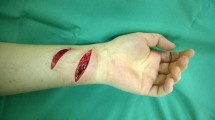Abstract
Purpose
Joint dislocations occur frequently in prehospital settings. The medical specialities of emergency physicians are heterogeneous. Decision making and the success rates of reduction attempt can vary greatly. The aim of this prospective multicentre study was to identify the factors most crucial for achieving successful prehospital reduction.
Methods
Study was conducted from 05/2012–05/2015 investigating cases of shoulder, patella and ankle joint dislocations in 16 emergency physician rescue stations. Parameters included: affected joint, type and use of medication, incidence and circumstances of reduction or reduction attempt and medical specialty as well as subjective skill status.
Results
In total 118 patients could be included. Mean age was 40.1 ± 21.3 years. Medical specialties were: n = 61 (51.7%) anaesthesiologists (A), n = 41 (34.5%) surgeons (S), and n = 16 (13.5%) internal medicine/others (I/O). Reduction attempt was performed in n = 97 (82.2%). With taking into account the complexity of the reduction (S) had significantly the highest success rates followed by (A) and (I/O). Regarding the applied medication there was neither a significant correlation between pain (p = 0.161) nor success of reduction (p = 0.09). A higher number of attempts does not improve the success rate (p ≤ 0.001), the pain level was no predictor for success of reduction attempt (p = 0.88).
Conclusion
A successful reduction is determined by the trias of affected joint, skill level and medical specialty of the physician. In each case this trias should be considered by the physician in charge and he must evaluate limitations and circumstances.







Similar content being viewed by others
Change history
14 March 2018
The original version of this article unfortunately contained a mistake.
References
Kroner K, Lind T, Jensen J. The epidemiology of shoulder dislocations. Arch Orthop Trauma Surg. 1989;108(5):288–90.
Simonet WT, et al. Incidence of anterior shoulder dislocation in Olmsted County, Minnesota. Clin Orthop Relat Res. 1984;186:186–91.
Sperner G, Benedetto KP, Glotzer W. Pathology, diagnosis and therapy of patellar dislocation. Sportverletz Sportschaden. 1990;4(2):69–72.
Lambers K, Ootes D, Ring D. Incidence of patients with lower extremity injuries presenting to US emergency departments by anatomic region, disease category, and age. Clin Orthop Relat Res. 2012;470(1):284–90.
Goost H, et al. Fractures of the ankle joint: investigation and treatment options. Dtsch Arztebl Int. 2014;111(21):377–88.
Helfen T, et al. Management of prehospital shoulder dislocation: feasibility and need of reduction. Eur J Trauma Emerg Surg. 2016;42(3):357–62.
Chin WW. The partial least squares approach to structural equation modeling. In: Marcoulides GA, editor. Modern methods for business research. Mahwah: Erlbaum; 1998. p. 295–358.
Wohlrath B, et al. The significance of early reposition in patients with visible malposition of the upper ankle joint. Z Orthop Unfall. 2016;154(6):612–7.
Duignan M, McGibney M. Patellar dislocation: not the bees knees. Int Emerg Nurs. 2017;31:36–40.
Longo UG, et al. Management of primary acute anterior shoulder dislocation: systematic review and quantitative synthesis of the literature. Arthroscopy. 2014;30(4):506–22.
Longo UG, et al. Treatment of primary acute patellar dislocation: systematic review and quantitative synthesis of the literature. Clin J Sport Med. 2017;27(6):511–23. https://doi.org/10.1097/JSM.0000000000000410.
Salonen EE, et al. Traumatic patellar dislocation and cartilage injury. Am J Sports Med. 2017;45(6):1376–82. https://doi.org/10.1177/0363546516687549.
Alkaduhimi H, et al. A systematic comparison of the closed shoulder reduction techniques. Arch Orthop Trauma Surg. 2017;137(5):589–99. https://doi.org/10.1007/s00402-017-2648-4.
Yang NP, et al. Epidemiological survey of orthopedic joint dislocations based on nationwide insurance data in Taiwan, 2000–2005. BMC Musculoskelet Disord. 2011;12:253.
Wroble RR, Nepola JV, Malvitz TA. Ankle dislocation without fracture. Foot Ankle. 1988;9(2):64–74.
da Silva M. Patellar dislocations. Gaz Med Port. 1951;4(2):375–83.
Colville MR, Colville JM, Manoli A 2nd, Posteromedial dislocation of the ankle without fracture. J Bone Jt Surg Am. 1987;69(5):706–11.
Canales Cortes V, Garcia-Dihinx Checa L, Rodriguez Vela J. Reduction of acute anterior dislocations of the shoulder without anaesthesia in the position of maximum muscular relaxation. Int Orthop. 1989;13(4):259–62.
Ceroni D, Sadri H, Leuenberger A. Anteroinferior shoulder dislocation: an auto-reduction method without analgesia. J Orthop Trauma. 1997;11(6):399–404.
Author information
Authors and Affiliations
Corresponding author
Ethics declarations
Conflict of interest
The authors declare that they have no competing interest.
Rights and permissions
About this article
Cite this article
Siebenbürger, G., Zeckey, C., Fürmetz, J. et al. Medical speciality, medication or skills: key factors of prehospital joint reduction. A prospective, multicenter cohort study. Eur J Trauma Emerg Surg 44, 637–642 (2018). https://doi.org/10.1007/s00068-018-0933-8
Received:
Accepted:
Published:
Issue Date:
DOI: https://doi.org/10.1007/s00068-018-0933-8




